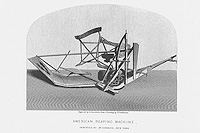Agricultural Machinery
Power Cultivator
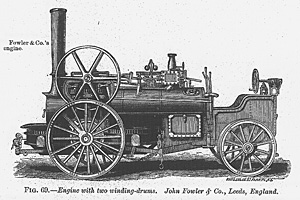 This is an image of a steam engine for winding power cultivator ropes. The engine was exhibited by J. Fowler Co. at the third Paris International Exposition of 1878. In the United Kingdom, in the 1840s, many experiments were conducted regarding plowing with the use of steam engines. In 1854, Fowler devised a method in which plows were pulled by a steam engine fixed on the ground. At the Paris International Exposition of 1878, which was held after Fowler's death, many of his company's products were exhibited.
This is an image of a steam engine for winding power cultivator ropes. The engine was exhibited by J. Fowler Co. at the third Paris International Exposition of 1878. In the United Kingdom, in the 1840s, many experiments were conducted regarding plowing with the use of steam engines. In 1854, Fowler devised a method in which plows were pulled by a steam engine fixed on the ground. At the Paris International Exposition of 1878, which was held after Fowler's death, many of his company's products were exhibited.
Since Roman times, a wooden implement called "plow" had been used as a tool for cultivating the earth. The tool was composed of a blade for digging the soil and a board for shifting the dug soil to one side. With the rapid spread of modern agricultural production methods, in 1837, J. Deere of the United States developed a steel plow, which was subsequently used in many of the country's farms. In the late 19th century, gang plows, comprising two, three or four plows, were developed. Many gang plows were exhibited at the fourth Paris International Exposition of 1889.
In terms of improvement of the motive power component, there were high expectations for the application of the steam engine to agricultural machinery, especially in the United States, a vast country experiencing a shortage of workers due to the American Civil War. However, steam engines were not actually very appropriate for pulling plows and other agricultural tools. This was because the steam engine itself was fairly heavy, and frequently making the soil too hard to cultivate with an engine-operated plow after it had moved over the ground.
In 1854, J. Fowler of England developed a power cultivator as indicated in the above image. This was improved to enable two steam engines placed on each side of a field to repeat tractions by turn. Subsequently, a new version was created to ensure that a single steam engine moved back and forth between the sides of a field. However, in the United Kingdom too, steam engine plowing failed to take off.
Until 1904, when B. Holt of the United States put into a practical use a track-type tractor (the model of today's caterpillars) with the use of a gasoline engine, agricultural power was provided mostly by human beings, as well as cattle and horses.
Reaper
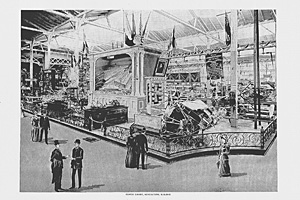 This is an image of McCormick's reaper exhibition booth at the Chicago International Exposition of 1893. The company began with the invention of an epoch-making reaper by C.H. McCormick, a farmer's son, in 1833 in the United States, which subsequently experienced a serious shortage of workers due to the American Civil War.
This is an image of McCormick's reaper exhibition booth at the Chicago International Exposition of 1893. The company began with the invention of an epoch-making reaper by C.H. McCormick, a farmer's son, in 1833 in the United States, which subsequently experienced a serious shortage of workers due to the American Civil War.
Originally, the reaper itself was invented in 1826 by P. Bell of Scotland based on the same principle as that of scissors. However, this kind of reaper was not widely used.
The reaper invented by McCormick Co. was a horse-drawn type. However, it was very innovative in that it automatically laid harvested wheat ears in a row and tossed them to the rear platform. The company's various reapers were exhibited at international expositions on many occasions, from the first London International Exposition of 1851 to the Chicago International Exposition of 1893. The image on the right depicts the reaper exhibited at the London International Exposition of 1851.
At the third Paris International Exposition of 1878, Aveling & Porter exhibited a steam engine reaper.
Threshing Machine
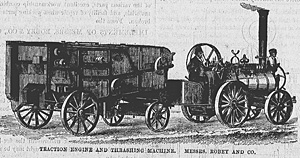 This is an image of a threshing machine pulled by a steam automobile. The machine with the automobile was exhibited by Robey Co. of England at the second London International Exposition of 1862. The company manufactured portable steam engines and threshing machines.
This is an image of a threshing machine pulled by a steam automobile. The machine with the automobile was exhibited by Robey Co. of England at the second London International Exposition of 1862. The company manufactured portable steam engines and threshing machines.
The first use of a threshing machine was in Scotland in 1786. Operated by water wheels, it was used in Scotland and England. Subsequently, the machine was upgraded from a stationary type to a portable one. Robey Co. of England exhibited portable steam threshing machines at the second London International Exposition of 1862 (the above image) and the second Paris International Exposition of 1867.
Combine
The most notable invention in the history of agricultural machinery was the "combine," a machine that performed reaping and threshing simultaneously. In the United States, in 1841, H. Moore obtained the first patent. In the 1840s, the machine began to be used in the Midwest, and especially in California. However, it was not until the 1880s that a practical steam engine type was developed. Featuring a heavy-weight steam engine, the original type was not used so widely; the full use of combines began in the 20th century, when a gasoline engine was developed.
Cultivating Machinery (Power Cultivator, etc.) (12 images)
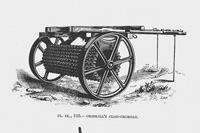 |
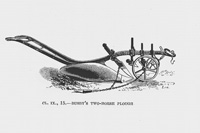 |
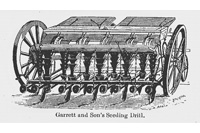 |
| Soil Crushing Machine | Two-horse Plow | Garrett & Son's Seeding Machine |
Reaper, Threshing Machine, etc. (12 images)
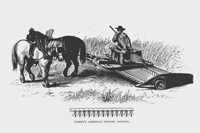 |
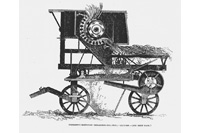 |
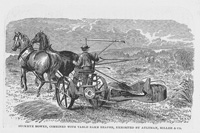 |
| Obed Hussey's Reaper | Garrett & Son's Threshing Machine | Aultman Miller's Reaper |
Other Agricultural Machinery (8 images)
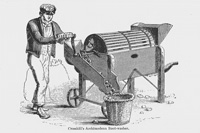 |
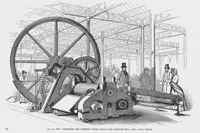 |
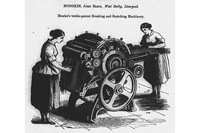 |
| Root Vegetable Washing Machine | Steam Sugar Cane Crushing Machine | Scutching Machine |
Agricultural Steam Engine (9 images)
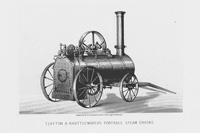 |
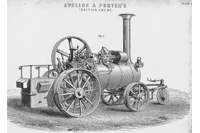 |
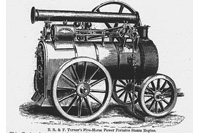 |
| Clayton & Shuttleworth's Portable Agricultural Steam Engine | Portable Agricultural Steam Engine Exhibited by Aveling & Porter Co. | Steam Engine Made by E. R. & F. Turner |
- References:
Grigg, David B.; Yamamoto, Shozo (et al)(tr).: Seiyo nogyo no henbo (Norin tokei kyokai, 1997) <DM71-G11>
Kashima, Shigeru.: Pari banpaku zekkei hakubutsukan (28) Yoroppa no nogyo kakumei in Seko n. 385 (1997.11) <Z16-72>
Mitsuhashi, Tokio.: Amerika ni okeru nokigu no hattatsu in Nogyo to keizaiv. 14 n. 9 (1948.9) <Z18-401>
Orwin, Charles Steward; Misawa, Takeo (tr).: Igirisu nogyo hattatsushi (Ochanomizu shobo, 1978) <DM71-34>)

